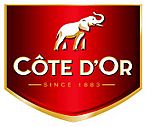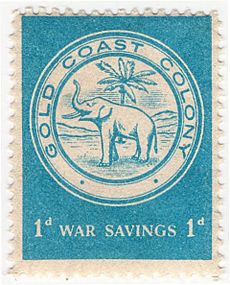Côte d'Or (chocolate) facts for kids
 |
|
| Private (1883–1906) | |
| Industry | Food |
| Fate | Sold to Buiswal-Leclef family in 1889, merged with Michiels in 1906 to form Alimenta S.A. |
| Founded | 1883 |
| Founder | Charles Neuhaus |
| Headquarters | |
| Products | Belgian chocolate |
| Owner |
|
Côte d'Or makes delicious Belgian chocolate. It is owned by a big company called Mondelez International. A man named Charles Neuhaus started Côte d'Or in 1883 in Schaerbeek, Belgium. The name 'Côte d'Or' means 'Gold Coast' in French. This name came from the Gold Coast, which is now Ghana. Ghana was a main place where cacao beans, used to make chocolate, came from.
Charles Neuhaus sold Côte d'Or in 1889 to the Buiswal-Leclef family. Later, in 1906, their company joined with another chocolate company called Michiels. Together, they formed a new company named Alimenta S.A.
Over the years, Côte d'Or was bought by different companies. In 1987, Jacobs Suchard bought it. Then, in 1990, Kraft General Foods bought Jacobs Suchard. In 2012, Kraft Foods split into different parts, and its chocolate brands became part of Mondelez International. So, Mondelez is the current owner of Côte d'Or.
People in Belgium love Côte d'Or chocolate. They eat about 600 million Côte d'Or products every year! The Côte d'Or factory in Halle, near Brussels, used to make huge amounts of chocolate every day. This included 1.3 million small chocolate bars called mignonnettes and two million Chokotoffs, which are chocolate toffees. Today, mignonnettes are made in Poland.
Contents
The Story of Côte d'Or Chocolate

The story of Côte d'Or began in 1883. That year, Charles Neuhaus opened a small chocolate shop. It was located in Schaerbeek, a town in the Brussels area of Belgium.
In 1889, Charles Neuhaus decided to retire. He sold his chocolate business to Joseph Bieswal and his wife, Maria Leclef. They started their own company called Compagnie Joseph Bieswal. Soon after, they joined with the Michiels chocolate company. In 1899, they moved their production to a larger building. This building was a former mill located in Anderlecht, across from the Brussels-Midi train station. Chocolate production stayed there until the 1980s.
How the Company Grew
In 1906, the two chocolate companies officially joined together. They created a new company called Alimenta S.A. This merger helped them combine their chocolate-making skills and machinery.
Also in 1906, the famous Côte d'Or logo was created. It showed an elephant standing in front of a palm tree and three pyramids. Lambert Michiels got the idea for this design from a stamp from Ghana. The logo has changed only a little bit since then. Today, it features just one elephant. The brand's writing style has also stayed the same.
The company, Alimenta S.A., grew even bigger. In 1908, they built new buildings and added more machines. This helped them make even more chocolate.
In 1911, the well-known Côte d'Or 'package' was created. This package holds two chocolate bars wrapped in golden-white paper. You can still find this classic package today.
A new type of candy called Supertoff appeared in 1929. This was a chewy toffee candy. Later, in 1934, the popular Chokotoff chocolate toffees were introduced.
The company continued to expand during these years. By 1930, they had 350 workers in Anderlecht. Côte d'Or also became known internationally. The brand was registered in the United States in 1931. In 1935, the Brussels World Fair helped Côte d'Or gain worldwide fame. They even created the Mignonette, a small chocolate bar, especially for this event.
Challenges During World War II
From 1940 to 1946, it was very hard to get good quality cocoa beans. This was because of World War II. So, Côte d'Or decided to temporarily stop using their main brand name. Instead, they used a different brand called Congobar. Also, one of their factories in Marseille, France, was destroyed in early 1943. This happened when German forces destroyed parts of the Vieux Port area. Because of this, Côte d'Or stopped making chocolate in Marseille. This made more room for the Congobar, which used lower quality ingredients.
After the War
After World War II ended, the Côte d'Or brand was brought back. The company kept creating new products. In 1952, they launched Pastador, a chocolate spread.
For the Universal Exhibition in Brussels in 1958, they launched a special praline bar. It was called "Dessert 58."
In 1965, Côte d'Or received a special honor. They were given the title "Purveyor to the Royal Court of Belgium." This means they were official suppliers to the Belgian royal family. The company grew even faster in the 1970s. They opened new sales offices in France and the Netherlands in 1972. They also opened offices in Switzerland and the UK in 1978. In 1974, a new factory was built in Seclin.
In 1982, the company Côte d’Or of America was started. In 1984, 101 years after it began, Côte d'Or shares were sold on the Brussels stock exchange. This meant that families no longer had complete control of the company. However, the Bieswal, Leclef, and Michiels families still owned most of the shares.
In 1987, two other companies, Nestlé and Jacobs Suchard, tried to buy Côte d'Or. This was a big surprise in the financial world in Brussels. The families who owned Côte d'Or knew they needed to grow. They also knew they needed more money than their current owners could provide.
So, they agreed to sell to Jacobs Suchard. The deal was worth a lot of money. Jacobs Suchard first bought 66% of the shares in 1987. By February 1989, they had bought all the shares. After this, Côte d'Or shares were no longer traded on the Brussels Stock Exchange.
Jacobs Suchard made some changes to the Belgian company. They invested a lot of money to make Côte d'Or a global brand for their group.
Three years later, in 1990, Jacobs Suchard became part of Philip Morris, a cigarette company. Philip Morris then put Côte d'Or into its Kraft General Foods group. This group was later renamed Kraft Jacobs Suchard. Côte d'Or remained a high-quality brand within this group.
In 2000, the parent company changed its name to Kraft Foods. Then, in 2012, Kraft Foods split again, and the chocolate and candy brands became part of Mondelēz International.
In 2013, Mondelēz was the top chocolate company in Belgium. They sold 35% of all chocolate in the country. Côte d'Or is a very important brand for Mondelēz, making up 21% of its value in Belgium.
Making Chocolate Fairly
There have been questions about how chocolate companies get their cocoa beans. In 2001, it became known that some children were being forced to work on cocoa farms in the Ivory Coast.
After this, Kraft (the owner of Côte d'Or at the time) and other chocolate companies signed an agreement. It was called the Harkin–Engel Protocol. They promised to stop the worst forms of child labor in their cocoa supply chains.
In October 2009, Kraft launched new Côte d'Or dark chocolate products in Europe. These were the first major chocolates to have the Rainforest Alliance Certified seal. This seal means that at least 30% of the cocoa in these chocolates came from farms that follow good environmental and social practices. These products first came out in France and Belgium. Kraft planned to sell these certified Côte d'Or chocolates in many other countries too. By the end of 2012, Kraft Foods aimed to use only cocoa beans from Rainforest Alliance Certified farms for all its Côte d'Or and Marabou chocolates. This meant using about 30,000 tonnes of certified beans.
See also
 In Spanish: Côte d'Or (chocolate) para niños
In Spanish: Côte d'Or (chocolate) para niños

